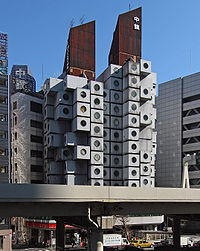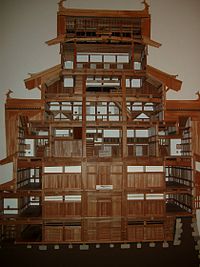- Metabolist Movement
-
In the late 1950s a small group of young Japanese architects and designers joined forces under the title of "Metabolism". Their visions for cities of the future inhabited by a mass society were characterized by large scale, flexible, and expandable structures that evoked the processes of organic growth. In their view, the traditional laws of fixed form and function were obsolete. Metabolism arose in post-World War II Japan, and so much of the work produced by the movement is primarily concerned with housing issues.
The group's work is often called technocratic and their designs are described as avant-garde with a rhetorical character. The work of the Metabolists has often been compared to the unbuilt designs of Archigram.[1]
After the disbanding of CIAM in 1958, the ideas of Team X were of great influence to young architects around the globe, including young Japanese architects. The World Design Conference of 1960 was held in Japan, and a group of young Japanese architects were involved with the planning. Under the guidance of Kenzo Tange, the architects Takashi Asada, Kisho Kurokawa, Kiyonori Kikutake, and writer Noboru Kawazoe often met and discussed the direction of Japanese architecture and urbanism. During the World Design Conference, the Metabolist group presented their first declaration as a bilingual pamphlet called Metabolism 1960: The proposals for a New Urbanism. Contributors to this work were Noboru Kawazoe, Kiyonori Kikutake, Fumihiko Maki, Masato Otaka, Kisho Kurokawa, and Kiyoshi Awazu. There are four copies of this pamphlet in libraries around the world; in the United States, one copy is found at Harvard University and one in the rare books collection of the College of Environmental Design at the University of California, Berkeley.[2] The ideas of Metabolism as implemented in modern culture were philosophical as well as architectural, and ostensibly based on Buddhist notions of impermanence and change.
The individual members of the group soon went their own way and their contributions to the Osaka Exposition of 1970 can be seen as their last major work.
Metabolist designs relied heavily on advanced technology, and they often consist of adaptable plug-in megastructures. Famous projects included the floating city in the sea (Unabara project), Kiyonori Kikutake's Marine City, Tower City, Ocean City, Wall City, Kisho Kurokawa's Agricultural City and Helix City. The most famous built example of Metabolism is Kurokawa's Nakagin Capsule Tower (1972).
Contents
Affiliated Projects
Japanese Metabolists
- Living in a capsule (Akira Shibuya 1966, Youji Watanabe 1967, Kisho Kurokawa 1970-72)
- Mega city planning for Tokyo (Kenzo Tange 1960)
Relations with Western Architecture
- Habitat 67 Montréal (Moshe Safdie 1967)
- Redevelopment Plan for the Modern Center of Montréal (1960s).
- Funnel city 'Intrapolis' (Walter Jonas 1960)
- Space city (Yona Friedman 1959-63)
- Overbuilding the city of Ragnitz (Günther Domenig 1963-69)
- Swimming Hotel Kairo (Justus Dahinden 1972)
- Akro-Polis leisure city (Justus Dahinden 1974)
- Leisure city Kiryat Ono near Tel Aviv (Justus Dahinden 1984)
Asian Context
- Golden Mile Complex, Singapore (Gan Eng Oon, William S.W. Lim and Tay Kheng Soon 1973)
The unity of pop and machine: Archigram
- Plug-in-City, Living Pod and Capsule Tower (Peter Cook 1964-66)
- Walking City and Instant City (Ron Herron 1964-70)
- Trickling Towers and Layer City (Peter Cook 1978-82)
See also
Notes
References
- Noboru Kawazoe, et al. (1960). Metabolism 1960: The Proposals for a New Urbanism. Bitjsutu Shuppan Sha.
- Kisho Kurokawa (1977). Metabolism in Architecture. Studio Vista. ISBN 978-0289707333
- Kisho Kurokawa (1992). From Metabolism to Symbiosis. John Wiley & Sons. ISBN 978-1854901194
- Thomas Daniell (2008). After the Crash: Architecture in Post-Bubble Japan. Princeton Architectural Press. ISBN 978-1568987767
Elements of Japanese architecture Styles Buddhist · Buke · Daibutsuyō · Gassho · Giyōfū · Hachiman · Hirairi · Hiyoshi (also called Hie) · Irimoya · Ishi-no-ma · Kasuga · Kibitsu · Nagare · Ōbaku Zen · Setchūyō · Shinden · Shinmei · Shinto · Shoin · Sukiya · Sumiyoshi · Taisha · Wayō · ZenshūyōA model of Himeji Castle
Building types Roof styles Structural Burdock piling · Chigi · Disordered piling · Engawa · Fusuma · Hisashi · Irimoya-zukuri · Irori · Jinmaku · Katōmado · Katsuogi · Kuruwa · Mokoshi · Moya · Nakazonae · Namako wall · Nightingale floor · Onigawara · Ranma · Shōji (see also washi) · Sōrin · Tamagaki · Tatami · Tokonoma · Tokyō · Tsumairi · ShibiGates and approaches Rooms Furnishings Outdoor objects Measurements Groups See also Categories:- Architectural styles
- Architecture groups
- Modernist architecture
- Architectural history
- Japanese architecture
Wikimedia Foundation. 2010.


